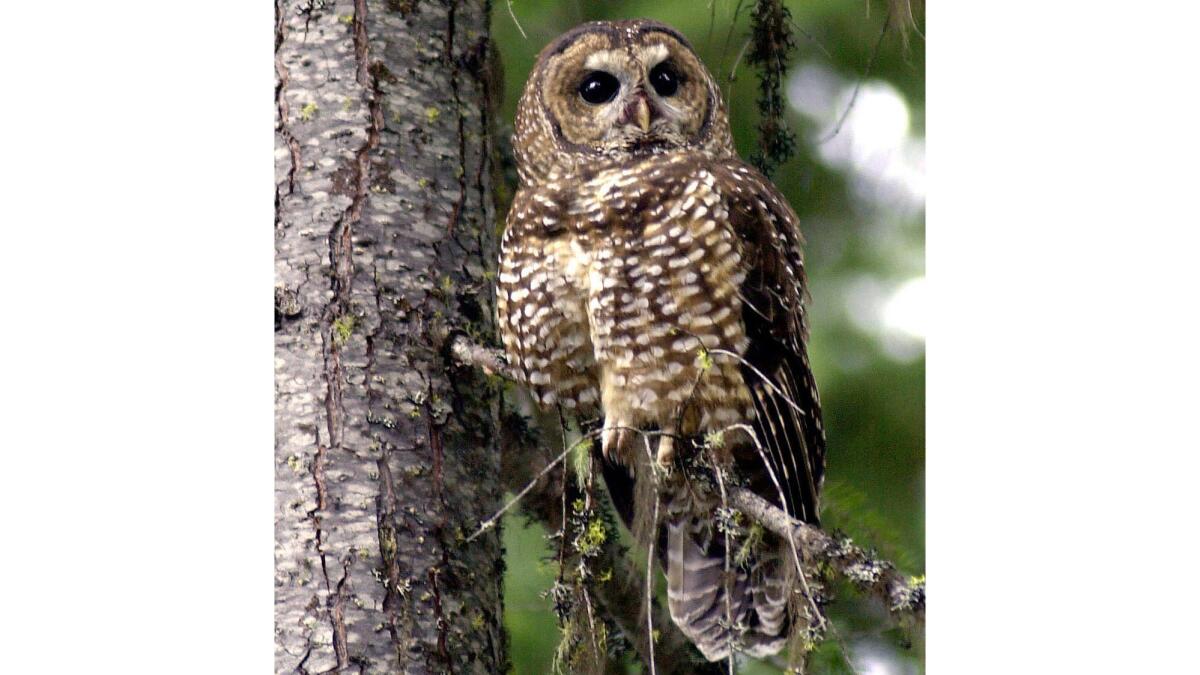Rat poison from marijuana farms is harming federally threatened northern spotted owls, study finds

The northern spotted owl has had many adversaries.
Three decades ago it was loggers, whose forays into the remote forests of the Pacific Northwest threatened the shy creatures, which have zero tolerance for the clatter of development.
Then it was the more aggressive and adaptable barred owls, which began moving into protected northern spotted owl habitats, forcing the federally threatened species to colonize less productive foraging grounds elsewhere.
Now, a new menace is taking root among the ancient trees: unpermitted marijuana farms suspected of spreading rat poison up the owl’s food chain, according to a study led by researchers at UC Davis in cooperation with the California Academy of Sciences.
“We have discovered a new potentially lethal threat to this struggling species that many conservationists have spent decades trying to save from extinction,” said Mourad Gabriel, lead author of the study and a researcher with the UC Davis Karen C. Drayer Wildlife Health Center.
Seven of 10 spotted owls and 34 of 84 barred owls collected between 2009 and 2013 tested positive for anticoagulant rodenticides, the study published Thursday in the journal Avian Conservation and Ecology shows.
The study area encompassed Humboldt, Mendocino and Del Norte counties, a region where increasing numbers of marijuana cultivation sites overlap with the owls’ hunting grounds, Gabriel said.
There are an estimated 15,000 marijuana farms in Humboldt County alone operating without regulatory oversight, Gabriel said.
“If no one is investigating the levels at which toxic substances are being placed on private marijuana grows out there,” he said, “the fragmented forest landscapes created by these sites can serve as source points of exposure for owls and other wildlife.”
Separate studies conducted by Gabriel in 2012, 2013 and 2015 were the first to link rat poison and illegal marijuana farms to the deaths of fishers, a weasel-like mammal living in the Pacific Northwest.
Scientists fear the beginning of recreational sales of marijuana in California could spur the creation of more illegal cultivation sites that could further contaminate rodents eaten by predators, including birds of prey, Gabriel said.
Anticoagulant rodenticides inhibit the ability of mammals and birds to recycle vitamin K, scientists say, resulting in clotting and coagulation problems including uncontrollable internal bleeding.
Images of dead and dying bobcats, mountain lions, coyotes and owls shared among residents in the vicinity of the Santa Monica Mountains National Recreation Area in 2016 attributed the animals’ condition to the ingestion of prey contaminated with rodenticides.
All spotted owls collected in the study were found dead in wilderness and timberlands and submitted to U.S. Fish and Wildlife Service field offices and the Humboldt State University Wildlife Museum in Arcata, Calif.
Efforts by federal biologists to remove and kill barred owls occupying designated habitats reserved for spotted owls provided tissue samples from that species, Gabriel said.
All of the owls collected were from remote forested lands with no nearby urban or agricultural settings, suggesting the sources were marijuana farms, Gabriel said.
Anticoagulants had been used until 2014, when California banned the sale to the public of so-called second-generation rat poison, which is more toxic than earlier versions and remains in a target’s body at such high levels that other animals feeding on a rat carcass often also die.
Anticoagulants rodenticides were not found, however, in rodents within the study area. But that was not unexpected, the study says, since rat poison is “acutely toxic and likely to kill rodents in a matter of days.”
The researchers said further study is needed to better understand the magnitude of the contamination and its effects on fledgling survival and embryos.
The study, which was funded by the U.S. Fish and Wildlife Service, was part of an effort to “build a scientific case for increased forest monitoring and species protection before it’s too late,” said Jack Dumbacher, curator of ornithology and mammalogy at the California Academy of Sciences.
More to Read
Sign up for Essential California
The most important California stories and recommendations in your inbox every morning.
You may occasionally receive promotional content from the Los Angeles Times.










